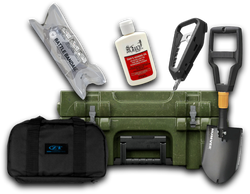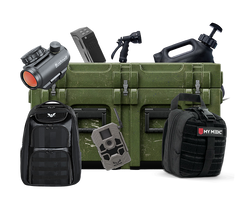How to Make a Tactical Walking Stick: A Comprehensive Guide
Table of Contents
- Introduction
- Understanding Tactical Walking Sticks
- Materials and Tools Needed
- Step-by-Step Guide to Crafting a Tactical Walking Stick
- Enhancing Your Tactical Walking Stick
- Conclusion
- FAQ
Introduction
Picture this: you're on a rugged trail, surrounded by towering trees, the scent of fresh pine in the air, and the thrill of adventure in your heart. Suddenly, the ground beneath you shifts, and you find yourself teetering precariously, grasping for stability. In moments like these, having a tactical walking stick can mean the difference between a graceful recovery and a nasty fall. But tactical walking sticks aren't just for stability; they can serve multiple purposes, from survival tools to self-defense equipment.
As outdoor enthusiasts and survivalists know, preparedness is key. A well-crafted tactical walking stick can enhance your outdoor experience, providing support during hikes and serving as a versatile tool in emergencies. In this comprehensive guide, we will delve into how to make a tactical walking stick from scratch. You will learn about essential materials, techniques, and tips to customize your walking stick to meet your needs.
By the end of this post, you will be equipped with knowledge that empowers you to create a tactical walking stick that not only supports you physically but also enhances your readiness for the unexpected. Whether you are a seasoned adventurer or a newcomer to the world of tactical gear, this guide will illuminate the path toward making your own walking stick.
Let’s explore the anatomy of a tactical walking stick, the tools you'll need, and the step-by-step process to craft a reliable companion for your outdoor excursions.
Understanding Tactical Walking Sticks
Before we dive into the creation process, it’s important to understand what makes a walking stick "tactical." Tactical walking sticks are designed for functionality and durability, often incorporating features that make them suitable for various outdoor activities. Here are some key characteristics:
1. Material Choices
The material you choose for your walking stick is crucial for its strength and weight. Common materials include:
- Wood: Traditional and aesthetically pleasing, wood offers a natural feel. Hardwoods like oak or hickory provide durability.
- Aluminum: Lightweight and resistant to corrosion, aluminum is a popular choice for those who prioritize portability.
- Fiberglass: Strong and flexible, fiberglass is resistant to breakage, making it a good choice for rugged use.
2. Multi-Functionality
A tactical walking stick can serve several purposes. Beyond providing support, it can include:
- Storage compartments: Hollow tubes can store survival gear, such as first aid kits or fire-starting tools.
- Defense features: A sturdy stick can be used as a self-defense weapon in emergencies.
- Built-in tools: Many tactical sticks come equipped with features like compasses, bottle openers, or fishing hooks.
3. Comfort and Grip
A good walking stick should feel comfortable in hand. Grip options include:
- Rubber grips: Offer excellent traction and comfort.
- Paracord wraps: Provide a customizable grip that can also be unraveled in emergencies.
- Ergonomic designs: Consider shapes that reduce strain during long hikes.
With this foundational knowledge, let’s begin the step-by-step process of creating your tactical walking stick.
Materials and Tools Needed
To craft a tactical walking stick, gather the following materials and tools:
Materials
- Main stick material: Choose between wood, aluminum, or fiberglass.
- Grip material: Rubber, paracord, or foam for the handle.
- Storage container: A lightweight, waterproof container (like a plastic tube) for storing survival gear.
- Accessories: Items such as a compass, fishing hook, or emergency whistle.
- Epoxy or strong adhesive: For assembling various components.
- Finish: Wood stain or paint for aesthetics and protection against the elements.
Tools
- Saw: For cutting your main stick to the desired length.
- Drill: To create holes for attachments or storage compartments.
- Sandpaper: For smoothing rough edges and surfaces.
- Heat source: To soften materials for bending (if needed).
- Measuring tape: For accurate measurements.
- Screwdriver: For attaching any screws or fasteners.
- Optional tools: If you're adding complex features, tools like a soldering iron or additional cutting devices may be needed.
Step-by-Step Guide to Crafting a Tactical Walking Stick
Step 1: Selecting the Right Length
The first step in making your tactical walking stick is determining the appropriate length. A general rule of thumb is that the stick should reach between your wrist and your armpit when standing upright. This ensures comfort and usability.
- Measure from the ground to your wrist or armpit.
- Cut your main stick material to this length, ensuring a clean, straight edge.
Step 2: Shaping the Stick
Now that you have your stick cut to size, it’s time to shape it for comfort and functionality.
- Use sandpaper to smooth any rough edges. Ensure the stick feels comfortable in hand.
- If desired, taper the top end of the stick for easier handling and aesthetics.
Step 3: Creating Storage Compartments
One of the best features of a tactical walking stick is its ability to store essential gear. Here’s how to create storage compartments:
- Hollow out sections: If using wood, you can drill a hole down the center of the stick to create a storage space. For aluminum or fiberglass, consider using a lightweight tube that can be securely attached.
- Insert your storage container: Attach a waterproof tube or container to the stick. This is where you can keep items like a small first aid kit, fire starter, or emergency supplies.
Step 4: Adding a Grip
A good grip is essential for comfort and control while using your walking stick.
- Wrap with paracord: If you choose to use paracord, start wrapping at the bottom of the stick, creating a comfortable grip that can also be unraveled in emergencies.
- Attach rubber grips: If using rubber, secure it tightly to the handle section for added comfort.
Step 5: Attaching Accessories
Enhance the functionality of your tactical walking stick by adding useful accessories.
- Compass: Drill a small hole near the top of the stick and securely attach a compass. Ensure it is easily visible and accessible.
- Fishing tools: If desired, integrate hooks or other fishing tools into the storage compartment.
Step 6: Finishing Touches
To protect your tactical walking stick from the elements and ensure it lasts for years, apply a finish.
- If using wood, apply a wood stain and sealant to protect against moisture and wear.
- For aluminum or fiberglass, consider a protective coat of paint or sealant.
Step 7: Testing Your Walking Stick
Before taking your tactical walking stick on an adventure, test it out.
- Stability test: Walk around with the stick to assess its balance and comfort.
- Functionality check: Ensure that all accessories are securely attached and functional.
Enhancing Your Tactical Walking Stick
Once you’ve completed your walking stick, consider ways to further enhance its capabilities:
1. Customizing Features
Your walking stick can be tailored to meet specific needs. Consider adding:
- Fire-starting tools: Store waterproof matches or a fire starter in the stick’s hollow section.
- Emergency whistle: Attach a whistle to the handle for easy access in emergencies.
2. Personalization
Make your tactical walking stick uniquely yours by:
- Adding your name or logo.
- Painting designs that reflect your personality or outdoor interests.
3. Joining the Crate Club Community
As you embark on your tactical journey, consider joining the Crate Club community. With monthly subscriptions tailored to different levels of preparedness, you can receive high-quality gear that complements your walking stick. Explore the Crate Club subscription services to find the right fit for your needs.
Crate Club Subscription Services
Conclusion
Creating a tactical walking stick is not just a project; it's an investment in your preparedness and outdoor experience. By understanding the materials, techniques, and features that make a walking stick tactical, you’ve equipped yourself with the knowledge to craft a tool that enhances your adventures and keeps you ready for anything.
Your tactical walking stick can serve multiple purposes, from providing stability on uneven terrain to acting as a survival tool in emergencies. As you prepare to hit the trails, remember that the right gear can make all the difference.
For those looking to expand their tactical gear collection, check out the Crate Club Shop. Explore a wide range of products that can further enhance your outdoor adventures and survival readiness.
FAQ
What materials are best for making a tactical walking stick?
The best materials for a tactical walking stick depend on your preferences. Wood offers a traditional feel, aluminum is lightweight and durable, and fiberglass provides flexibility and strength.
How do I determine the right length for my walking stick?
Stand upright and measure from the ground to your wrist or armpit. This measurement typically ensures comfort and usability.
Can I customize my walking stick with features?
Absolutely! You can add features like storage compartments, compasses, fire-starting tools, and even fishing gear to enhance functionality.
How do I maintain my tactical walking stick?
Regularly inspect your walking stick for wear and tear. If made of wood, apply a sealant to protect against moisture. Clean and maintain any accessories to ensure they function properly.
Where can I find quality tactical gear?
For high-quality tactical gear, consider subscribing to Crate Club or exploring the Crate Club Shop. They offer curated gear that meets the needs of outdoor enthusiasts and survivalists.
By crafting your tactical walking stick, you're not only enhancing your outdoor experience but also fostering a mindset of preparedness that can serve you well in any situation. So gather your materials, unleash your creativity, and take your first steps towards making a walking stick that is truly your own!
Comparte este artículo



